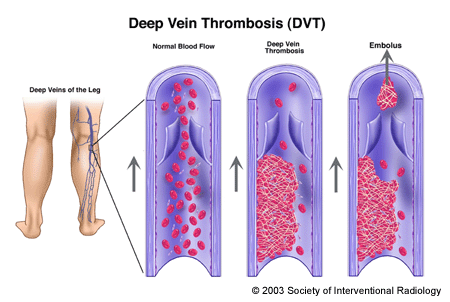Deep Vein Thrombosis
Deep vein thrombosis (DVT) is the formation of a blood clot, known as a thrombus, in the deep leg vein. It is a very serious condition that can cause permanent damage to the leg, known as post-thrombotic syndrome, or a life-threatening pulomnary embolism. In the United States alone, 600,000 new cases are diagnosed each year. One in every 100 people who develops DVT dies. Recently, it has been referred to as "Economy Class Syndrome" due to the occurrence after sitting on long flights.
The deep veins that lie near the center of the leg are surrounded by powerful muscles that contract and force deoxygenated blood back to the lungs and heart. One-way valves prevent the back-flow of blood between the contractions. (Blood is squeezed up the leg against gravity and the valves prevent it from flowing back to our feet.) When the circulation of the blood slows down due to illness, injury or inactivity, blood can accumulate or "pool," which provides an ideal setting for clot formation.

Risk Factors
- Previous DVT or family history of DVT
- Immobility, such as bed rest or sitting for long periods of time
- Recent surgery
- Above the age of 40
- Hormone therapy or oral contraceptives
- Pregnancy or post-partum
- Previous or current cancer
- Limb trauma and/or orthopedic procedures
- Coagulation abnormalities
- Obesity
Symptoms
- Discoloration of the legs
- Calf or leg pain or tenderness
- Swelling of the leg or lower limb
- Warm skin
- Surface veins become more visible
- Leg fatigue
Post-thrombotic Syndrome
Post-thrombotic syndrome is an under-recognized, but relatively common sequela, or aftereffect, of having DVT if treated with blood thinners (anticoagulation) alone, because the clot remains in the leg. Contrary to popular belief, anticoagulants do not actively dissolve the clot, they just prevent new clots from forming. The body will eventually dissolve a clot, but often the vein becomes damaged in the meantime. A significant proportion of these patients develop permanent irreversible damage in the affected leg veins and their valves, resulting in abnormal pooling of blood in the leg, chronic leg pain, fatigue, swelling, and, in extreme cases, severe skin ulcers. While this use to be considered an unusual, long-term sequela, it actually occurs frequently, in as many as 60-70 percent of people, and can develop within two months of developing DVT. There is increasing evidence that clot removal via interventional catheter-directed thrombolysis in selected cases of DVT can improve quality of life and prevent the debilitating sequela of post-thrombotic syndrome.
Treatments include Blood Thinners and Catheter-Directed Thrombolysis.


